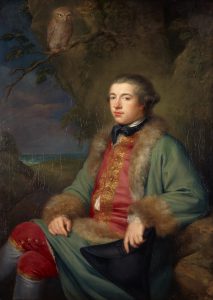James Boswell’s Grand Tour
Beginning late in the 17th century, The Grand Tour—the extended journey through Europe undertaken by young British gentlemen to finish off their education—became popular and fashionable for many young British sons of the aristocracy. Typically, the young men already had a thorough grounding in Greek and Latin literature and some interest in art. Two to three years spent living abroad, accompanied by their tutors, offered them the opportunity to absorb the art and cultures they were visiting and improve their language skills. An added benefit was the greater freedom the young travellers experienced on the Continent, where their involvement in drinking, gaming and romantic liaisons posed as little inconvenience to their families as possible.
In terms of sheer reading pleasure and attention to detail, perhaps no accounting of The Grand Tour is more fascinating than that of James Boswell.

George Willison, “James Boswell,” Scottish National Portrait Gallery, Edinburgh. Painted in Rome while Boswell was on The Grand Tour in 1765.
Boswell, best known as the author of The Life of Johnson, what many consider the greatest biography in the English language, first visited London from his native Edinburgh in 1760 at the age of 20. The city’s culture—and its women—dazzled him and he began a three-year struggle with his father, an eminent judge, to remain permanently in the capital. Father and son ultimately worked out a compromise and just before his second London visit in 1762 where he was first introduced to Johnson in a bookseller’s back parlor, Boswell began keeping a diary, London Journal, 1762-1763, a practice he would continue for 33 years.
From these voluminous entries The Journals, 1762-95, we are able to vicariously follow Boswell’s adventures through Germany, Switzerland and Italy as he embarks on his Grand Tour. Travel in the 18th century was both difficult and expensive, and travellers typically carried little money. Instead, they took letters of credit from their London banks, which they then presented in major cities. After a year of studying law in gloomy Utrecht, the sunny climes and independence must have been irresistible to the twenty-four year old Boswell as he departed for Holland in 1764, escorted off by none other than Johnson himself. Whether due to cost or preference, he travelled without a tutor. The freedom this afforded him and Boswell’s own somewhat pompous self-image only adds to the appeal of his journal entries.
Yet Boswell did truly possess a genuine interest in the sites of European learning and classical antiquity. After leaving Johnson behind, he set his sights on and aggressively pursued obtaining interviews with two other great thinkers, Jean Jacques Rousseau and Voltaire, both of whom were living in exile near Geneva. Although ill, Rousseau agreed to dine with him. Boswell, always the able conversationalist, rose enough to the occasion—talking of books, religion, art and of course, women—that he was invited to return. Voltaire was slightly less accommodating, but Boswell’s earnestness ultimately earned him the great writer’s grudging respect.
Boswell’s journals record these unforgettable dialogues in detail, but he also gives equal attention to less scholarly intentions. He wrote down everything that happened to him, what everyone said, what they ate, what they drank, how they dressed, how they travelled, along with plenty of descriptions of his meetings with all the pretty maids, wealthy wives, and available streetwalkers.
Boswell then continued his tour down to Italy, where he was the first Englishman to visit the interior of Corsica. The account of his visit here describes this little known land to Europeans in the 18th century in meticulous detail. As well as discussing the history, politics and culture of Corsica, Boswell writes about the land, the animals, the language and the people, even comparing the small stature and hard working nature of the Corsicans to the Highland Scots. His meeting with Pasquale di Paoli, the island’s leader, results in a lifelong friendship and helps to later spread Paoli’s revolutionary fervor to England through pamphlets and other writings.
By 1766, Boswell’s Grand Tour was nearing completion. As a favor to Rousseau, he agreed to accompany Rousseau’s mistress to London before returning to Scotland to take his final law exam. “When a man is tired of London he is tired of life,” Johnson famously said. Boswell, apparently never tired, and his short stop in London allowed for a brief affair with the philosopher’s mistress.
A little over ten years later, in 1773, Boswell finally succeeded, after many tries, in enticing his famous friend Dr. Johnson, who was by then in his mid-sixties, to accompany him on a tour through Scotland. Setting out from Edinburgh, the two men skirted the eastern and northeastern coasts of Scotland, passing through St. Andrews, Aberdeen and Inverness, and then on into the highlands where they spent several weeks on various islands in the Hebrides, including Skye, Coll and Mull.
Our own grand tour of Scotland and the Hebrides follows much of the same route that Boswell and Johnson trekked, and includes a stay at the Taychreggan Hotel in Kilchrenan, the actual site where the pair stopped for refreshment over 200 years ago. Boswell’s account of the journey, Journal of a Tour to the Hebrides, became the precursor to his famous biography. Whether experienced in person or from the comfort of your living room, it might just be the perfect accompaniment for interested readers to recreate such a storied trip.
